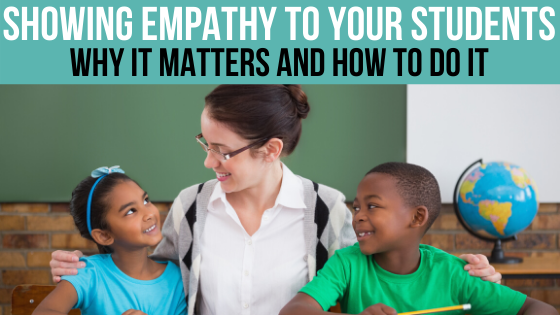Tips For Showing Empathy To Students In Your School
Empathy is such an important skill. Research shows that students who have a strong sense of empathy show more pro-social behavior, have stronger relationships, and even experience more academic success. Thankfully, it seems that schools are increasingly focusing on social emotional learning and training in social skills such as empathy. Knowing how important empathy is, I have read a lot of research about how to encourage empathy in the school community, and I have found that one of the key ways to encourage empathy in your students is for the educators in the school to treat each student with empathy. Keep reading to learn why this is an important strategy, and how you can practice it at your school!
Why Showing Empathy To Your Students Is Important
They are people: Even though our students are young and do not have fully developed brains and bodies yet, they are still people. Just like us adults, they have feelings, they have good days and bad days, and they have life experiences that affect them. So often, it can be easy to fall into a mindset of expecting students to be obedient robots who must not thwart our agenda for the day. However, this isn’t realistic and is likely to leave everyone frustrated. Instead, it is important to view our students as they are - people!
They may be coming from difficult situations: Unfortunately, many of the students we work with enter the school day with so much baggage. Whether they are or have experienced trauma, are battling a mental or physical illness, or are living in poverty and/or food insecurity, our students’ experiences out of school may be very challenging. This means that once they get to school, they are already overwhelmed, frustrated, or fearful before instruction and classwork even starts. By recognizing this, and responding with empathy instead of frustration, we are able to meet them where they are and set them up for real success.
Students learn by watching us: One of the most effective strategies for teaching empathy to students is to model it. By showing empathy to the students we work with, they get to see what it practically looks like and how it makes others feel. By modeling empathy, we can contribute to a positive school culture, which then encourages students to practice empathy themselves.
How To Show Empathy To Your Students
Acknowledge and understand students’ feelings: A big part of empathy is being able to consider how the other person is feeling. Acknowledging how your students feel will help them to understand their emotions and show them that you care enough to notice how they are feeling. One way to do this is by simply stating, “It seems like you are sad. Do you want to talk about it?”
Ask how you can help: After you have acknowledged how the student is feeling, a great follow up question is, “What can I do to help you?” Sometimes, students may feel like teachers and other educators are out to get them. When we notice that they have a need and we willingly step in to support them, it speaks volumes about how much they are valued and cared for.
Help the student manage their emotions: Many students are dealing with things at home that we can’t even begin to imagine. When they come to school, they are already carrying so much baggage. Instead of getting frustrated when they are misbehaving or being difficult, it is important to understand that these are little people overwhelmed by big emotions. Getting frustrated and continuing to fight/argue isn’t going to solve the problem. Instead, use the 3 R’s developed by Dr. Bruce Perry - Regulate, Relate, then Reason. By helping the student manage their strong emotions first, the students will see that you care about what they are experiencing and are willing to work with them on what they need most.
Be willing to give a little: This can be a tricky one, because you don’t want to enable negative behavior. However, sometimes making exceptions to rules or expectations can be just what a student needs. For example, a jr. high student I know lost her mom this past summer. Unfortunately, her last days of summer were spent in hospital rooms. In this situation, her teachers decided that she would be exempt from summer homework - which was a great move. Giving a little grace is sometimes just what the students need, and can really show that you care about them as a person.
Meet the student where they are: “Everyone in our room gets what he/she needs.” This was a great quote from a teacher I once worked with when she was asked about giving special accommodations to certain students. Some students work better in small groups, some work better individually. Some students need consistent positive reinforcement, and some can work fine without it. Being willing to be flexible and responsive to the different needs of your students is a great way to show them empathy. AND, it helps the other students to see what it looks like to practice empathy in a practical way.
Empathy is an important skill, and thankfully is something that schools are taking seriously. However, empathy doesn’t just end with teaching it to our students. One of the best ways to create a culture of empathy in our schools is to practice it ourselves.






